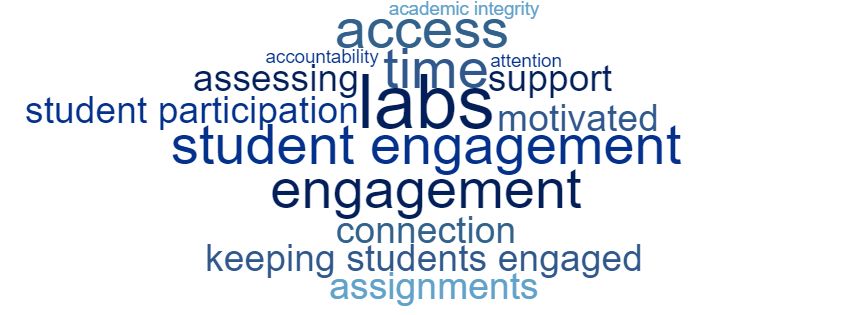What Human Biology Instructors Learned from Teaching During COVID
Posted on 7/23/21 by Andra Bowditch and Laura Snider
It may seem hard to believe, but it’s been more than a year since the COVID-19 pandemic forced schools to close and prompted a huge shift to online education. Throughout these difficult past few semesters, educators at every level have faced a variety of challenges as they’ve worked to help their students succeed. Now summer 2021 is here, the mad scramble of spring 2020 is in the rear-view mirror, and the United States is starting to emerge from the pandemic. What will instructors take away from this momentous year of teaching?
We recently surveyed human biology instructors about teaching during the pandemic and how they envision the future of education. A total of 139 instructors—about 40% at the college level and 60% at the high school level—responded to our online survey and shared their personal experiences in their own words. Most (77%) had not taught online before the pandemic. While the year was difficult and fraught in many ways, the vast majority of instructors say that the experience has broadened their perspectives and that their teaching methods will be permanently changed as a result.
You can download a report of the full study results here.
“I hope that what we have learned isn't quickly lost due to the desire to get back to "normal". There is so much out there now and hopefully, we can keep advancing and teaching to students' strengths!” wrote one instructor. Indeed, 9 out of 10 survey respondents agreed with the statement that "Going ‘back to normal’ shouldn't be the goal; the goal should be to go back to something better."
Most instructors also agreed that the experience of the last year changed them as teachers, and their teaching would be different from now on. “There is always a learning experience to take [away] from anything you do,” one instructor commented. “This experience through the pandemic has definitely taught me a lot about myself as a teacher and my teaching style and preferences.”
A big and sudden change
Before the pandemic, virtually all the instructors had taught in person, and fewer than one in four had experience in teaching online, whether synchronously, asynchronously, and/or as part of a hybrid course.
Once the pandemic began, virtually all the instructors surveyed (98%) experienced online teaching in some shape or form. While most high school and middle school instructors were able to teach in person at some point during the last year, only around 6 in 10 of college instructors were able to offer in-person instruction.
The challenges: personal connections; content and curriculum
When asked to tell us about the challenges of teaching during the pandemic, most instructors brought up how, when in-person interactions with their students were suddenly lost, overall learning was impacted. Around half of instructors said that student engagement was of concern, and a third worried that student accountability was difficult to ascertain and maintain. Some instructors also noted that collaboration and communication among students and between students and instructors could be difficult.

A word cloud illustrating commonly mentioned terms in respondents' descriptions of the challenges of online teaching.
As one instructor eloquently noted:
“Teaching is far more than just curriculum and it is not pouring content into an empty student vessel. It is about human connection and if nothing else [the] pandemic should have proved that."
That said, the nuts and bolts of content and curriculum were also cited as a challenge by about half of instructors surveyed. The rapid switch to remote teaching had some instructors struggling to find suitable material for online teaching. Instructors also noted difficulties with assessing students’ comprehension of materials, and expressed concerns about academic integrity.
The advantages: flexibility, efficiency, learning at your own pace
Despite the challenges, only 15% of instructors agreed that “From my perspective, there are no silver linings to be found in the experience of teaching during this pandemic.” In other words, for 85% of instructors, online teaching had its advantages.
 A word cloud illustrating commonly mentioned terms in respondents' descriptions of the advantages of online teaching.
A word cloud illustrating commonly mentioned terms in respondents' descriptions of the advantages of online teaching.
First, 7 in 10 instructors mentioned the flexibility of online teaching as a big positive. Flexibility of both schedule and of location were cited, allowing teachers to prepare and students to learn under all kinds of circumstances. Students tend to share these views—in a recent Best Colleges survey, flexibility was one of the big draws for college students enrolling in online courses.
Another aspect of online teaching viewed favorably by instructors was efficiency. Many instructors said that they liked having all the resources they needed at their fingertips. Instead of paper handouts that students could lose, everything was there for students online to access whenever they needed. (“I will never collect another paper homework. Only uploads,” wrote one teacher.) Some respondents were particularly appreciative of the ability to make and view recorded versions of lectures, and others found grading to be simpler.
“It's forced me to be so much more organized and clear and I have everything laid out in advance with all the necessary materials. I feel a greater sense of calm during the week because I've already made all the materials for the week so students can access it whenever they want, not when they are just in school. I really love having more flexibility in my day to work when I have the mental state rather than being run by bells and a rigid schedule. Normal school feels a lot like prison to me.”
Flexibility and efficiency come together to provide students the opportunity to learn at their own pace. A number of instructors specifically brought up self-paced learning as one of the positive aspects of online teaching.
Where do we go from here?
Many instructors are looking forward to seeing their students in the classroom again, with 96% hoping to return to some form of in-person teaching. Yet, now that they have the experience, six of ten instructors hope to also do some online teaching. Given that just 23% had previously taught online, this finding represents a profound change in teachers’ skills, comfort levels, and approaches to online teaching.
When reflecting on the overall experience, only 18% of instructors said they really didn’t like online teaching and would rather never do it again. Despite the disruptions and challenges they faced this past year, instructors are determined to make their students’ learning experiences and their own teaching experiences better than before.
Here’s how one instructor summed up the effect teaching during the pandemic had on their future approach to teaching:
"This situation forced me to explore alternative resources I otherwise would not have explored. For example, I was a paper-person...and I did not want to take the time to figure out how to create quality pre-lab (and auto-graded) content on my school's LMS; but now I see the great advantage both in my own effort and time.... I guess that the pandemic has forced me to get comfortable using the new technologies and resources available, so that I can teach my students how to use them effectively to help them learn.”
We would like to thank all the instructors who responded to this survey.
Want a full report of the data from this survey? Download this slide deck.
Be sure to subscribe to the Visible Body Blog for more anatomy awesomeness!
Are you an instructor? We have award-winning 3D products and resources for your anatomy and physiology course! Learn more here.



